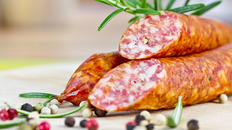Meats and Sausages
Arbatine
Arbatine is a classical Lithuanian sausage, made with beef, pork and wheat flour. In Lithuanian "Arbatine" means "tea."
There is a Polish version "Metka Herbaciana" and German "Teewurst." Teewurst contains 30 to 40 percent fat, which makes it particularly easy to spread.
The name, which means tea sausage, is said to derive from the habit of serving sandwiches at tea time.
| Materials | Metric | US |
|---|---|---|
| Beef | 700 g | 1.54 lb. |
| Semi-fat pork (shoulder) | 200 g | 0.44 lb. |
| Back fat, pork belly | 80 g | 3 oz. |
| Starch or wheat flour | 20 g | 3/4 oz. |
| Water | 250 ml | 1 cup |
Ingredients per 1000g (1 kg) of materials
| Salt | 25 g | 4 tsp. |
| Cure #1 | 2.0 g | 1/2 tsp. |
| Black pepper | 2.0 g | 1 tsp. |
| Coriander | 1.0 g | 1/2 tsp. |
| Sugar | 2.0 g | 1 tsp. |
| Fresh garlic, smashed | 3.0 g | 1 clove |
Instructions
- Using knife cut back fat into 6 mm (1/4") cubes and place in a refrigerator. Grind beef and pork through 2-3 mm plate (1/8") and refreeze for 30 minutes. Dissolve salt, cure, pepper, and spices in 1/2 of water. Grind meats again, slowly adding water with dissolved spices.
- Mix ground beef with remaining 1/2 of water then add pork and mix again. Add cubed fat and mix until the mixture feels sticky.
- Stuff into 24-30 mm pork or sheep casings. Make 30 cm straight links or keep in pairs.
- Bake for 30-60 minutes at 100° C (212° F). Stop baking when internal meat temperature reaches 40° C (104° F). Don't overcook, you are baking the surface of the sausage only.
- Cook in 80° C (176° F) water until internal meat temperature reaches 72° C (160° F). This should take about 30 minutes.
- Shower with cold water, then cool in the air to 15° C (59° F).
- Smoke for 2-3 hours with medium hot smoke at 35-45° C (95-113° F).
- Keep refrigerated.
Notes
Arbatine does not need to be cooked, it is usually consumed cold.


















